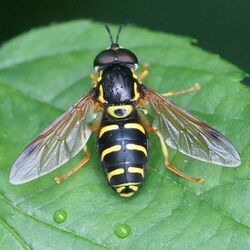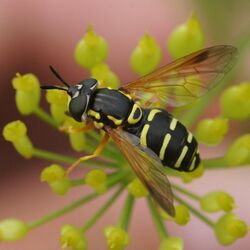Biology:Chrysotoxum festivum
| Chrysotoxum festivum | |
|---|---|

| |
| male | |

| |
| female | |
| Scientific classification | |
| Domain: | Eukaryota |
| Kingdom: | Animalia |
| Phylum: | Arthropoda |
| Class: | Insecta |
| Order: | Diptera |
| Family: | Syrphidae |
| Genus: | Chrysotoxum |
| Species: | C. festivum
|
| Binomial name | |
| Chrysotoxum festivum | |
| Synonyms | |
Chrysotoxum festivum is a species of hoverfly.[1]
Identification
External images
For terms see Morphology of Diptera
Wing length 8·25–12 mm. Wing with a small, square, dark spot. Thorax with two grey longitudinal stripes. Katepisternum normally with yellow spot. Apical antennomere shorter than antennomeres 1 and 2 together.
Keys and accounts
- Coe R.L. (1953) Syrphidae [2]
- Van Veen, M. (2004) Hoverflies of Northwest Europe [3]
- Van der Goot,V.S. (1981) De zweefvliegen van Noordwest - Europa en Europees Rusland, in het bijzonder van de Benelux[4]
- Bei-Bienko, G.Y. & Steyskal, G.C. (1988) Keys to USSR insects. Diptera [5]
Distribution
Palaearctic Fennoscandia South to Iberia and the Mediterranean basin. Ireland eastwards through Europe into Greece, Turkey and European Russia then through Siberia to the Pacific coast. Japan. North India.[6]
Biology
Habitat :Deciduous woodland clearings and open areas in scrub woodland. Grassland with scrub.[7] Flowers visited include white umbellifers, Calluna, Chaerophyllum, Cirsium arvense, Euphorbia, Galium, Hieracium, Hypochoeris, Narthecium, Origanum, Potentilla erecta, Ranunculus, Rosa rugosa, Rubus idaeus, Sambucus nigra, Senecio, Solidago canadensis and Solidago virgaurea.[8]
The flight period is May to September, with peaks in June and August.
References
- ↑ Stubbs, Alan E.; Falk, Steven J. (1983). British Hoverflies: An Illustrated Identification Guide. British Entomological & Natural History Society. pp. 253, xvpp.
- ↑ Coe, R.L. (1953) Diptera: Syrphidae. Handbks.ident.Br.insects, 10(1): 1-98. R.ent.Soc.London.pdf
- ↑ Van Veen, M. (2004) Hoverflies of Northwest Europe: identification keys to the Syrphidae. 256pp. KNNV Publishing, Utrecht.
- ↑ Van der Goot,V.S. (1981)De zweefvliegen van Noordwest - Europa en Europees Rusland, in het bijzonder van de Benelux. KNNV, Uitgave no.32: 275pp. Amsterdam.
- ↑ Bei-Bienko, G.Y. & Steyskal, G.C. (1988a) Keys to the Insects of the European Part of the USSR, Volume V: Diptera and Siphonaptera, Part I. Amerind Publishing Co., New Delhi. ISBN:81-205-0080-6.
- ↑ Fauna Europaea
- ↑ Speight, M.C.D. (2011). "Species accounts of European Syrphidae (Diptera)". Syrph the Net, the Database of European Syrphidae 65: 285pp. http://www.diptera.info/downloads/StN_Species_Accounts_Glasgow_2011.pdf.
- ↑ de Buck, N. (1990) Bloembezoek en bestuivingsecologie van Zweefvliegen (Diptera, Syrphidae) in het bijzonder voor België. Doc.Trav. IRSNB, no.60, 1-167.
External links
Wikidata ☰ Q2744823 entry
 |


